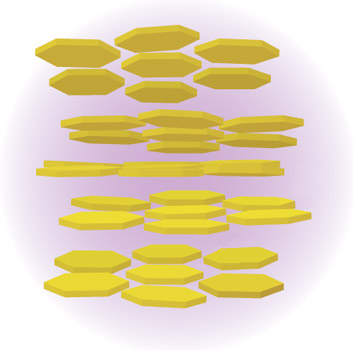- Home
- News
- Spotlight on Science
- Charged colloidal...
Charged colloidal platelets self organise into layers
18-06-2012
Entropy-driven self-organisation of anisometric colloids is generally determined by their shape. Rod-like particles follow an isotropic-nematic-smectic phase sequence while plate-like particles develop along the isotropic-nematic-columnar route. A novel smectic B phase has now been observed in a charged colloidal platelet system where the platelets self organise into layers rather than columns.
Share
The formation of isotropic-nematic-columnar phases for platelets has been predicted by theory and simulations of platelet systems. However, the existence of smectic phases, where the platelets are oriented in layers, has never been predicted. In contrast, experimentally, some layered liquid crystal phases have been reported a few times, such as the smectic A and lamellar phase. Recently, we have discovered the smectic B phase. In this phase, the particle directors are oriented along the layer normal and particles themselves exhibit hexagonal ordering within the layers (Figure 1). This rare phase has so far been observed exclusively in the thermotropic liquid crystal world of rod-like mesogens [1]. Here we report an experimental observation of the smectic B phase in a suspension of charged colloidal platelets.
 |
|
Figure 1. Smectic B phase for idealised gibbsite platelets. |
The success of finding the unexpected smectic B phase was made possible by the particular design of the experimental system. Charge stabilised hexagonal platelets of gibbsite (Al(OH)3) with a large D/L ratio (diameter/thickness) were dispersed in a solvent with a very low ionic strength, dimethyl sulfoxide (DMSO). The use of DMSO leads to a long range for the electrostatic Coulomb repulsion between platelets. While one would expect the system to have a tendency to build a smectic phase with increasing repulsion range, the fact that intralayer hexagonal order occurs is unexpected. It is believed that the long repulsion range between the platelet’s faces and edges is needed for a platelet system to arrange itself in the smectic B phase. This is why in aqueous systems, where the salinity usually dominates over the counter ion concentration, the latter does not affect the Debye screening length, making it impossible to induce the difference in the repulsive potential range (The Debye screening length affects the range of the electrostatic repulsive potential and is related to the ionic strength/salinity). As a result, aqueous gibbsite suspensions only show the formation of nematic and columnar phases.
Using a specialised microradian X-ray diffraction setup [2] at beamline BM26 (DUBBLE) [1], a detailed characterisation of this new phase was performed. The 2D scattering pattern is shown in Figure 2. The very anisotropic pattern shows peaks at small and at large q vectors (denominated qS and qL, respectively) predominantly oriented normal to each other, indicating that the structures at the two length scales are oriented perpendicular to each other. The peaks in the qL wedge indicate lamellar and smectic ordering while the peaks in the qS wedge are the reflections of the hexagonal order within the smectic layers.
 |
|
Figure 2. Full SAXS pattern of the smectic B phase of gibbsite platelets in DMSO. |
These experimental results unambiguously demonstrate the existence of a smectic B phase in the colloidal platelet system. Furthermore, it shows that the manipulation of interactions leads to a new richness in the phase behaviour of colloids, which is important for example for controlling the shape of growing polymers that use templates based on liquid crystals.
Principal publication and authors
Lyotropic smectic B phase formed in suspensions of charged colloidal platelets, D. Kleshchanok (a), P. Holmqvist (b), J.M. Meijer (a), and H.N.W. Lekkerkerker (a), J. Am. Chem. Soc. 134, 5985-5990 (2012).
(a) Van’t Hoff Laboratory, Debye Institute for Nanomaterials Science, Utrecht University (The Netherlands)
(b) Soft Condensed Matter Group, Institute of Complex Systems (ICS-3), Forschungszentrum Juelich (Germany)
References
[1] P. Oswald and P. Pieranski, Smectic and Columnar Liquid Crystals (Taylor & Francis Group, Boca Raton, 2006).
Top image: TEM image of gibbsite platelets.



